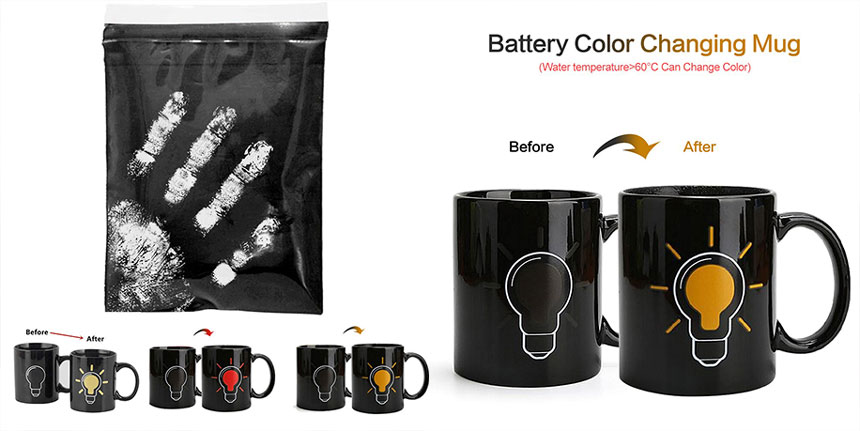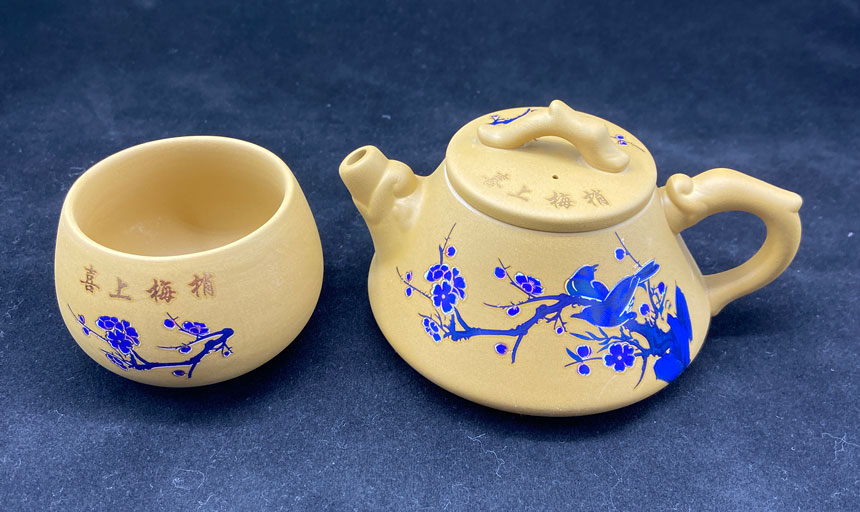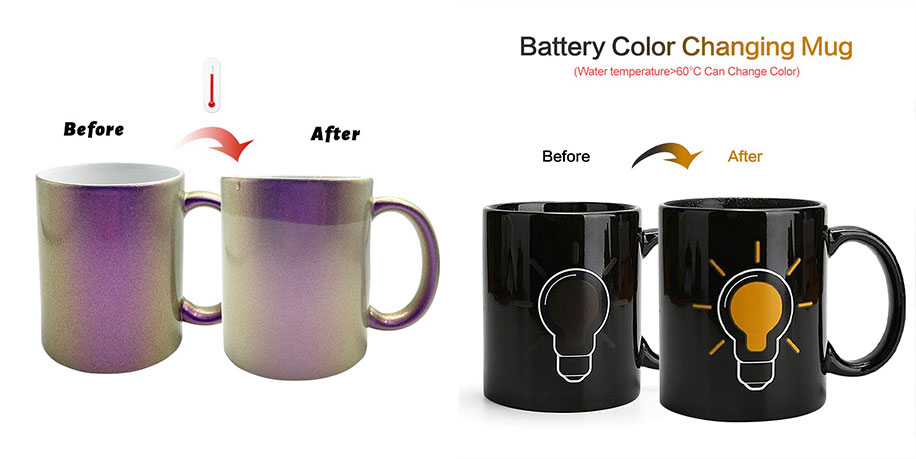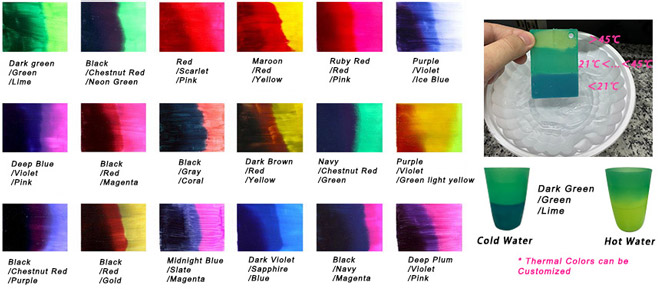categories
recent posts
Thermochromic powder (thermochromic pigment), one of iSuoChem's hot selling special effect pigments, has consistently proven popular in the color-changing pigment market. Its application in ceramic products is growing rapidly. We often receive inquiries from customers about how to use thermochromic powder on ceramics. Therefore, we've compiled this blog, drawing on relevant information, over a decade of practical user experience, and our expertise.
This blog will comprehensively explain the application techniques of thermochromic powder on ceramic surfaces, including suitable printing and application methods, detailed procedures, solutions to common problems, and precautions. Whether creating thermochromic ceramic mugs, temperature-indicating cookware, or creative ceramic crafts, mastering the correct application method is crucial. This blog will explain how to select the appropriate thermochromic material, prepare the substrate, apply the color-changing layer, and apply a protective coating to ensure a durable and effective color-changing effect.
Thermochromic powder (TCP) is a type of effect pigment that reversibly changes color with temperature. It is a capsule-type pigment prepared from an electron-transfer organic compound system. When the ambient temperature reaches its specific color change temperature, the material's molecular structure undergoes a reversible change, resulting in a different color state. This property provides a new approach to adding value to ceramic products and avoiding market homogeneity and price wars.
Tips: Irreversible thermochromic pigment or irreversible thermochromic ink is also an important thermochromic pigment/ink. But in ceramic industries, we fewly use this type.
Thermochromic powders typically have a particle size between 1 and 10 microns and are encapsulated using microencapsulation technology, which imparts a certain degree of temperature resistance and chemical stability. However, as organic compounds, heat sensitive pigment powders have limited high-temperature resistance. They can withstand temperatures of 230°C for short periods (approximately 10 minutes), but long-term operating temperatures should not exceed 75°C. This characteristic makes the application location of thermochromic powders on ceramics crucial; they should be placed away from direct heat exposure.
Pic#A Thermochromic pigment powder
Understanding the basic properties and applications of thermochromic powders is the first step in successfully applying them to ceramic products. Next, it's necessary to select the appropriate application process and material formulation based on specific product requirements.
Thermosensitive powders are primarily applied to ceramic surfaces through printing processes. Different printing techniques have their own characteristics, suiting different design requirements and production volumes. Choosing the right printing method is crucial for ensuring the desired color-changing effect, production efficiency, and cost control.
Screen printing is the most common and stable method for applying thermochromic powders to ceramic surfaces. It is particularly suitable for flat or slightly curved ceramic surfaces. This method transfers thermochromic printing ink to the ceramic surface via a screen, enabling precise control of ink layer thickness, ensuring a distinct and uniform color change.
Specific steps:
Drying and Curing: Select the appropriate drying method based on the ink type:
Process Advantages:
Precautions:

Pic#B Thermochromic ink for ceramics
The spraying process is suitable for large areas or irregularly curved ceramic products. It achieves a uniform coating and is relatively simple to operate, but material utilization is low.
Key Points:
Applications:
Advantages and Limitations:
Pad printing and transfer printing provide effective solutions for ceramic products with unique shapes or high-precision patterns.
Pad Printing Process:
Transfer Printing Technology:

Pic#C Thermochromic ink for ceramics
|
Printing Method |
Applicable Scenarios |
Advantages |
Limitations |
Recommended Thermochromic Powder Content |
|
Screen Printing |
Flat/simple curved surfaces, multi-color patterns |
Low cost, stable effect, controllable ink layer |
Limited adaptability to complex curves |
2-20% |
|
Spray Coating |
Large areas/complex curved surfaces |
Uniform coverage, suitable for any shape |
High material waste, strict environmental requirements |
2-5% |
|
Pad Printing |
Small areas/special shapes |
High precision, multi-color capability |
Small printing area per operation |
5-15% |
|
Transfer Printing |
Mass production/complex patterns |
High resolution, high production efficiency |
High initial plate-making cost |
According to ink formula |
Choosing the appropriate printing method requires comprehensive consideration of product design, production volume, cost, and quality requirements. In actual production, multiple printing processes are often combined to achieve optimal results and economic benefits, depending on the specific parts and functional requirements of the ceramic product.

Pic#D Thermochromic ink printing
The successful application of thermochromic powders to ceramic products requires not only the appropriate printing method but also a scientific and rational coating preparation and curing process. This step is directly related to the stability of the thermochromic effect, the durability of the coating, and the safety of the product.
The preparation of thermochromic ceramic coatings is a key step in the application process, and its quality directly determines the color-changing performance and physical properties of the final product. Depending on the application requirements, thermochromic ceramic coatings can be prepared in either oil-based or water-based systems.
Preparation Method for Oil-Based Thermochromic Ceramic Coatings:
Preparation of Water-Based Thermochromic Ceramic Coating:
Precautions:
Constructing a Multi-Layer Coating System
For thermochromic ceramic products that are intended for long-term use or food contact (such as cookware and tableware), a multi-layer coating system is recommended to protect the thermochromic layer while ensuring product safety. Typical three-layer construction method:
Base layer (ceramic coating):
Intermediate layer (thermochromic layer):
Top Layer (Transparent Protective Layer):
This multi-layer design offers the following advantages:
|
Coating Layer |
Primary Function |
Material Requirements |
Thickness Range |
Curing Conditions |
|
Base Layer |
Basic adhesion, heat resistance |
High-adhesion ceramic coating |
20-40μm |
200-280°C |
|
Thermochromic Layer |
Temperature-responsive color change |
Thermochromic ceramic coating |
15-25μm |
According to coating type |
|
Protective Layer |
Protection, food safety |
Highly transparent ceramic coating |
10-15μm |
150-180°C |

Pic#E thermochromic ink supplier + thermochromic pigment supplier - iSuoChem thermochromic mugs
The curing process has a crucial impact on the final performance and color-changing effect of the thermochromic ceramic coating. Improper curing conditions may result in reduced color-changing performance or coating defects.
Common Curing Methods:
Key Control Parameters:
For specialized applications, such as ceramic cookware, the curing process requires more precise control. Patent CN107760068A states that when applying a thermochromic indicator coating on the surface of cookware, the transparent ceramic protective layer should be cured at 150-180°C. This relatively mild curing condition helps preserve the properties of the thermochromic material while ensuring the coating's durability.
Through scientific coating preparation and precise curing control, ideal color-changing effects and a long service life can be achieved in thermochromic ceramic products.
Successfully applying thermochromic powder to ceramic products requires not only mastering the correct process but also paying attention to a number of key factors to ensure stable, safe, and reliable product performance. The following are special considerations for using thermal pigment powder to ceramics, covering aspects such as material selection and process control.
Thermochromic Powder Type Selection:
Substrate Compatibility:
Storage Conditions:
Thermochromic inks/pigments are suitable for a variety of substrates: paper, fabric, metal, glass, ceramic, plastic, etc. Materials should be stored in a sealed, dry, dark place away from direct sunlight.
Ideal storage temperature: 5-30°C, relative humidity below 60%. Unused thermochromic inks/paints should have their openings sealed to prevent solvent evaporation and moisture intrusion. Follow the "first-in, first-out" principle to avoid performance degradation caused by prolonged storage.
Temperature Management:
Processing temperatures must be kept below 200°C, with an optimal range of 120-180°C. High-temperature exposure time should be minimized, with no more than 10 minutes at 230°C. Avoid localized overheating and use uniform heating. For multi-layer coating systems, control the curing temperature of each layer to prevent overheating of the underlying layer.
Solvents and Additives:
Equipment Selection:
Thermochanging ceramic mugs are one of the most common and widely accepted applications on the market. These products typically use a thermochromic pigment powder between 31-45°C. When hot water is poured into the mug, the pattern or color changes, providing a visual indication of the water temperature and preventing burns.
The thermochromic indicator coating on cookware surfaces, described in patent CN107760068A, represents a typical example of a functional application. By applying a thermochromic coating to locations such as pot handles, users can intuitively understand the pot's temperature and avoid overheating.
High-end ceramic products (such as precious porcelain) utilize the precise thermochromic properties of thermochromic pigments to create anti-counterfeiting markings. Consumers can verify the authenticity of the product through a simple temperature change test.
Artists and designers use thermal color changing powder to create interactive ceramic artworks, creating dynamic visual effects through temperature changes, adding interest and engagement to the work.
Combining thermochromic powders with different color-changing temperatures can create a richer range of temperature-responsive effects. For example:
The low temperature zone (31°C) displays one color change; the medium temperature zone (45°C) adds a second color change; and the high temperature zone (60°C) triggers a third color change.
This blend of three-color thermochromic powders can be used to indicate different temperature levels.

Pic#F iSuoChem Three-Color thermochromic technology
Combining thermochromic technology with other functional materials to develop smart ceramic products that respond comprehensively to environmental conditions: thermochromic + Light-sensitive: Responding simultaneously to changes in temperature and light.
With advances in materials science and printing technology, the application areas of thermochromic ceramic products will continue to expand. iSuoChem is also actively developing various cosmetic-grade and food-grade thermochromic powders. This will continue to be a future research and development trend.
Possible Causes: Insufficient thermochromic powder added, too thin an ink layer, inappropriate background color.
Solution: Increase the thermochromic pigment powder content to 5-20%; increase Increase the number of printing/spraying cycles; use a white or light-colored background.
Possible Causes: Insufficient ceramic surface preparation, incomplete curing, material mismatch.
Solution: Enhance surface cleaning and roughening; adjust curing temperature and time; use a ceramic-specific primer.
Possible Causes: Overheating, UV exposure, chemical attack.
Solution: Strictly control process temperature; add UV absorbers; avoid strong acid or alkaline environments.
Possible Causes: Partial irreversible changes caused by excessive temperature, material quality issues.
Solution: Lower operating temperature; replace high-quality thermochromic materials; check for incompatible substances.
By paying attention to these key considerations, the success rate and quality stability of thermochromic ceramic products can be greatly improved.
the professional team to service !